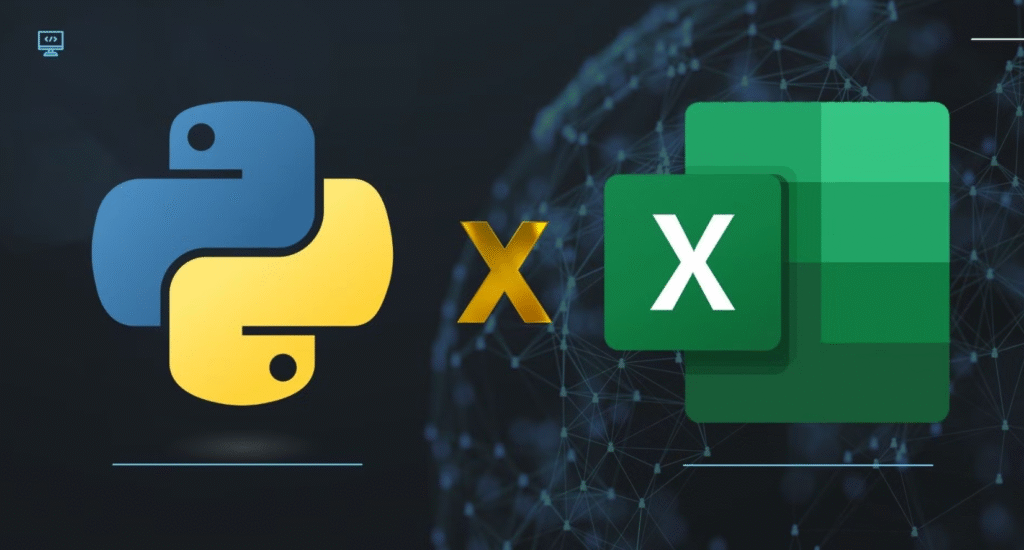
The Growing Role of Data Analysis in Decision-Making
In today’s world, organizations thrive on data-driven decisions. Whether it’s a small business monitoring customer trends or a large enterprise optimizing global operations, the ability to analyze data accurately is crucial. However, using only one tool often creates limitations, leading professionals to combine different platforms for better outcomes. This is where data analysis with Excel & Python comes in as a powerful duo. Excel provides familiarity, accessibility, and easy visualization, while Python offers automation, scalability, and advanced analytical power. By integrating both, individuals can process large datasets, automate repetitive work, and present results clearly. As industries grow more competitive, the partnership of Excel and Python ensures that businesses and professionals are not just reacting to data but actively shaping strategies from it.
Understanding the Strengths of Excel in Data Analysis
Excel has been the go-to tool for decades, thanks to its accessibility and ease of use. For many professionals, it’s the first step into the world of data analysis, with features that make calculations, reporting, and visualization straightforward. Its built-in formulas, pivot tables, and conditional formatting allow users to spot patterns and trends quickly without needing programming knowledge. Excel also shines in creating interactive dashboards that decision-makers can understand at a glance. In smaller datasets, it handles filtering, sorting, and chart creation effortlessly. Many organizations still rely heavily on Excel because it integrates seamlessly with everyday workflows like budgeting, project tracking, and performance monitoring. For beginners or business users, Excel provides a low barrier to entry while still offering powerful data tools that can transform raw numbers into meaningful insights.
Why Python Has Become a Game-Changer for Data Analysis
While Excel is user-friendly, Python takes analysis to another level by handling large, complex datasets that Excel struggles with. Python’s flexibility allows analysts to automate repetitive tasks, create predictive models, and apply advanced statistical methods. Its ecosystem of libraries—such as Pandas for data manipulation, NumPy for numerical calculations, Matplotlib and Seaborn for visualization—makes it a favorite among data professionals. Python also integrates well with machine learning frameworks, giving analysts the ability to move from descriptive to predictive and prescriptive analysis. Beyond technical power, Python is open-source, meaning a supportive community is constantly improving and sharing resources. Compared to Excel, Python is better suited for projects requiring speed, accuracy, and scalability. For professionals aiming to grow beyond spreadsheets, learning Python unlocks an entirely new level of analytical possibilities.
The Benefits of Combining Excel & Python for Analysis
Relying on just Excel or just Python may limit your efficiency, but combining both can lead to the best results. Excel works exceptionally well as a presentation tool, offering clear tables, graphs, and dashboards that executives and teams understand. On the other hand, Python can handle the heavy lifting by cleaning messy datasets, automating transformations, and running advanced models. For instance, an analyst could use Python to process millions of rows of raw sales data, then export the polished results into Excel for reporting. Likewise, financial models built in Python can feed outputs into Excel dashboards for quick review. By pairing the strengths of both tools, professionals can maximize efficiency, reduce manual work, and provide reliable insights that are easy to share. This combination allows analysts to bridge the gap between technical analysis and practical business reporting.
Practical Methods to Integrate Excel and Python
Integrating Excel with Python has become easier with specialized libraries that connect the two seamlessly. Tools such as openpyxl allow Python scripts to read and write Excel files, while xlwings makes it possible to automate Excel directly using Python code. With these integrations, repetitive Excel tasks—like generating weekly reports—can be automated, saving hours of manual effort. Analysts can import large Excel datasets into Python for cleaning and transformation, then export polished results back into an Excel workbook. Additionally, Python scripts can create charts or calculations that Excel alone would struggle with, providing advanced insights while still maintaining Excel’s user-friendly interface. These integrations eliminate the need to choose between tools; instead, they create a smooth workflow that combines Excel’s accessibility with Python’s scalability. For businesses, this hybrid approach means faster reporting cycles and more accurate results.
Step-by-Step Workflow: From Excel to Python and Back
A typical workflow combining Excel and Python starts with importing data. Analysts often begin with an Excel file, where initial inputs are collected. Using Python libraries such as Pandas, this data can be imported into Python for cleaning, transformation, and deeper analysis. Once inside Python, analysts can apply advanced statistical techniques, generate detailed visualizations, or build predictive models. After processing, the results can be exported back into Excel, where they are structured into reports or dashboards. This back-and-forth workflow ensures data integrity and maximizes efficiency: Python handles the technical computation, while Excel simplifies communication with non-technical stakeholders. Over time, this workflow becomes a powerful system that not only saves time but also ensures accuracy across reporting processes. For professionals, mastering this cycle is an essential step toward becoming a more versatile analyst.
Common Challenges and How to Overcome Them
Despite the clear advantages of combining Excel and Python, some challenges often arise. Large datasets may overwhelm Excel, causing files to crash or slow down. The solution is to process those datasets in Python first before bringing smaller, summarized outputs back into Excel. Another challenge is the learning curve for Python, especially for those accustomed only to spreadsheets. Breaking the learning process into small, manageable steps—starting with simple data imports and basic analysis—makes it less intimidating. File compatibility and formatting issues can also cause delays; here, using standard Python libraries like openpyxl helps ensure smoother data exchanges. Additionally, maintaining clean, well-structured datasets reduces errors and makes transitions between tools easier. While these challenges are real, they can be overcome with practice, proper setup, and consistent workflow design. Ultimately, the effort pays off with greater efficiency and more reliable insights.
Real-World Applications Across Industries
The combination of Excel and Python is applied in countless industries with remarkable results. In business reporting, Python can quickly process sales data from multiple sources, while Excel creates clear dashboards for executives. In finance, analysts use Python to build risk models and export the findings into Excel for decision-making. Marketing teams rely on Python to process customer data, then visualize campaign results in Excel for presentations. In operations and supply chain, Python optimizes forecasting models while Excel organizes the output into actionable plans. Even in healthcare, data analysts rely on Python to handle large patient datasets, while Excel simplifies reporting for medical teams. The versatility of combining both tools ensures that professionals across fields can apply them effectively. By adapting workflows to specific industry needs, organizations can achieve greater accuracy and efficiency in their data analysis processes.
Best Practices for Building a Data Analysis Workflow with Excel & Python
To make the most of data analysis with Excel & Python, professionals should adopt best practices that improve efficiency and reduce errors. One key practice is to use the right tool for the right task—Excel for presentation and quick summaries, Python for computation and automation. Maintaining clean and organized datasets is equally important, as messy data creates unnecessary complexity in both tools. Documenting workflows ensures that projects remain understandable and replicable by teams. Analysts should also regularly update their skills, since both Excel and Python frequently introduce new features and libraries. Another best practice is building modular workflows, where parts of the process can be reused for different projects, saving time in the long run. By combining discipline, organization, and technical skill, analysts can create workflows that consistently deliver high-quality results. Over time, this structured approach leads to stronger, more reliable insights.
Frequently Asked Questions (FAQ)
1. Can I learn Python if I already know Excel?
Yes, knowing Excel gives you a strong foundation in data handling, which makes learning Python easier. You’ll already understand concepts like data cleaning, filtering, and analysis, which translate well into Python.
2. Is Python replacing Excel for data analysis?
Python is not replacing Excel but complementing it. While Python handles large datasets and automation, Excel remains essential for presentation, dashboards, and quick analysis.
3. What are the best libraries for working with Excel in Python?
The most popular libraries include openpyxl, xlwings, and pandas. These allow you to read, write, and automate Excel tasks directly from Python.
4. Do I need coding experience to combine Excel with Python?
Basic coding knowledge helps, but you don’t need to be an expert. Many tutorials and resources make it easy for Excel users to start using Python gradually.
5. How do businesses benefit from using both tools together?
Businesses gain efficiency, accuracy, and flexibility. Python handles complex computations, while Excel provides clear reports for decision-makers, creating a balanced workflow.





